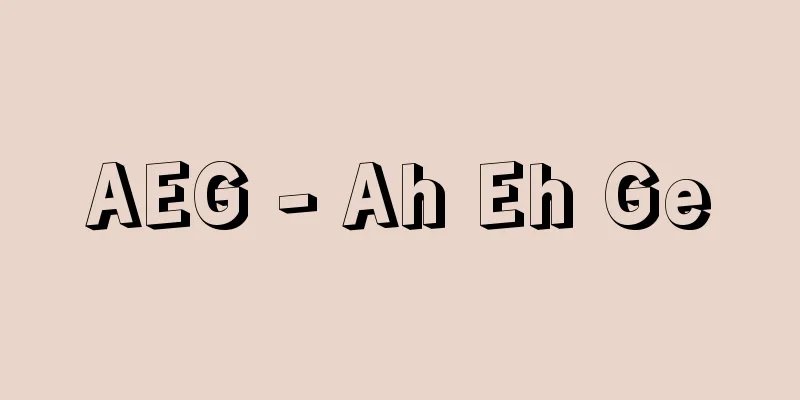AEG - Ah Eh Ge

|
Since its founding in 1883, this prestigious German company has manufactured all kinds of electrical machinery, from nuclear power plants to locomotives, transformers, and even various home electrical appliances. Along with Siemens and Philips of the Netherlands, it dominated the European electrical industry, but in 1997, its parent company Daimler-Benz (now Daimler AG) absorbed it into a division as part of a large-scale restructuring of its business structure, bringing an end to its long history. Before it was dissolved, its headquarters were in Frankfurt am Main. It began in 1883 when mechanical engineer Emil Rathenau (1838-1915) established the German Edison Applied Electric Company in Berlin with the support of Siemens-Halske. The company then rapidly expanded due to its unique management method of not only selling the products it produced, but also establishing and managing the companies that would become its customers. In 1887, the company name was changed to AEG (short for Allgemeine Elektricitäts-Gesellschaft), which means "general electrical company," and in 1894 it became independent from Siemens-Halske. By 1913, together with Siemens, AEG controlled 80% of the entire German electrical industry, and the founder's dream of building a huge global general electrical manufacturer was realized. Emil died in 1915 during World War I, and his son Walter Rathenau (1867-1922) became the second president at the age of 48. Walter Rathenau later became a politician and served as foreign minister during the Weimar Republic after World War I, but was assassinated in 1922. He is also known for writing many books on managerial and economic democratization during his lifetime. By 1923, AEG controlled 1,838 companies in Germany and abroad, and its total assets reached 15 billion Reichsmarks. The company suffered serious damage during the Second World War, but quickly began to rebuild, and started manufacturing and selling power generation, electrochemical, metallurgical, and household electrical appliances, and continued to develop smoothly while continuing the company's tradition of placing importance on research and development. In 1966, the company absorbed Telefunken, a communications equipment manufacturer that was a joint venture with Siemens, and actively promoted diversification of its business, from nuclear power generation to industrial and automation systems. However, after suffering a large deficit due to the direct hit of the oil crisis in 1974, the company actively tried to restructure by selling shares in affiliated companies and reducing staff, but was unable to overcome its deficit (in the meantime, the company name was changed to AEG Telefunken in 1978), and was affected by the severe recession that hit the West German economy after the second oil crisis, and in 1982 it posted an operating loss of 900 million marks and was on the verge of bankruptcy. In the same year, the government provided 600 million marks in export guarantees and 24 banks provided syndicated loans totaling 1.1 billion marks in an effort to rebuild the company. In 1985, the company was acquired by Daimler-Benz, which was actively diversifying its business, and in 1986 the company name was changed to AEG again. As a result, AEG was incorporated as the general electric machinery division under Daimler-Benz, a pure holding company (whose main business was stock ownership), along with Mercedes-Benz, the automobile division, DASA, the aerospace division, and Daimler-Benz Interservices, the service division. However, in 1997, Daimler-Benz embarked on a large-scale restructuring, converting its pure holding company into an operating holding company (a holding company with a high proportion of business activities other than stock ownership as its primary business), reconsidering its ever-expanding diversification policy, and embarking on a large-scale reorganization and restructuring of its business with the aim of strengthening its core automotive business. As a result, AEG was dissolved (its legal status was lost). The system automation division was sold to Siemens, and the other divisions such as electronics and diesel engines were absorbed into Daimler-Benz itself, bringing to a close a corporate history of over 100 years. [Takeshi Yuzawa and Nobutaka Kazama] Subsequent developmentsIn 1996, the home appliance division was sold to Electrolux of Sweden, and the transportation business was reorganized as ABB Daimler-Benz Transportation Group GmbH (Adtranz) (later sold to Bombardier Inc. of Canada). The AEG brand name was purchased by Electrolux in 2005, but several divisions of the former AEG remain and still use AEG as their brand name. [Editorial Department] [References] | | | | |Source: Shogakukan Encyclopedia Nipponica About Encyclopedia Nipponica Information | Legend |
|
1883年の発足以来、原子力発電所から機関車、変圧器、さらには各種家庭電気製品に至るまで、あらゆる電気機械を製造してきたドイツの名門企業。ジーメンス、オランダのフィリップスとともにヨーロッパ電機産業に君臨してきたが、1997年に親会社のダイムラー・ベンツ(現ダイムラー社)の大規模な事業構造の再構築に伴い一部門として吸収されるなどして、その長い歴史に幕を閉じた。法人格消滅以前の本社はフランクフルト・アム・マインに置かれていた。 1883年機械技師のエミール・ラーテナウ(1838―1915)がジーメンス‐ハルスケ社の支援を受けて、ドイツ・エジソン応用電気会社をベルリンに設立したときに始まる。その後、同社は生産した製品を販売するだけではなく、その販売先となる企業をも自ら設立し経営するという独自の経営方法によって急激に発展していった。1887年社名を「総合電機会社」を意味するAEG(Allgemeine Elektricitäts-Gesellschaftの略)と変更し、1894年にはジーメンス‐ハルスケ社から独立した。1913年にはジーメンスとともに、全ドイツ電機産業の8割を支配するまでになり、ここに世界的な巨大総合電機メーカーをつくりあげるという創業者の夢は実現されるところとなった。第一次世界大戦の最中の1915年、エミールは没し、息子ワルター・ラーテナウ(1867―1922)が48歳で第2代社長に就任する。ワルター・ラーテナウは、その後、政治家としても活躍し、第一次世界大戦後のワイマール共和国時代の外相ともなったが、1922年、暗殺者の凶弾に倒れ、その生涯を終えた。彼は、その生涯に経営民主化ないし経済民主化に関する多くの著作を残したことでも知られている。1923年には、AEGはドイツ国内・外に1838社の企業を支配し、その総資産は150億ライヒスマルクに達していた。 第二次世界大戦で同社も甚大な被害を受けたが、いち早く企業再建に取り組み、発電、電気化学、冶金(やきん)、家庭用電気機器等の製造・販売を開始し、同社の研究開発を重視する伝統を受け継ぎながら、その後順調に発展を遂げた。1966年には、通信機器製造メーカーで、ジーメンスとの合弁会社であったテレフンケン社を吸収するとともに、原子力発電から産業・自動化システム等、事業の多角的展開を積極的に推し進めていった。しかし、1974年に石油危機の直撃を受けて大幅な赤字を出して以来、傘下企業の株式の売却や人員の削減等、積極的にリストラに努めたが、その赤字体質を脱却することができず(その間、1978年には社名をAEG・テレフンケンと改称)、第二次石油危機後の西ドイツ経済を襲った深刻な不況の影響を受け、1982年に営業損益で9億マルクの赤字を出し、倒産の危機に瀕(ひん)した。同年、政府による6億マルクの輸出保証、取引銀行団24行による総額11億マルクに上る協調融資により再建が目ざされた。1985年、積極的な事業の多角化を展開していたダイムラー・ベンツに買収され、1986年には社名をふたたびAEGと改称した。その結果、純粋持株会社(株式所有を主たる事業とする)であるダイムラー・ベンツの下で、自動車部門のメルセデス・ベンツ、航空宇宙事業部門のDASA、サービス部門のダイムラー・ベンツ・インター・サービスとともに、その総合電機事業部門として傘下に組み込まれることとなった。しかし、1997年、ダイムラー・ベンツが大規模なリストラに踏み切り、それまでの純粋持株会社を事業持株会社(株式所有を主たる事業としない事業活動の比率の高い持株会社)へ転換するとともに、拡大の一途を遂げてきた多角化路線を見直し、本業である自動車事業の強化を目ざして事業の大規模な整理・再編に踏み切った結果、AEGは解体された(法人格の消滅)。システム・オートメーション部門はジーメンスに売却され、その他のエレクトロニクス、ディーゼルエンジン部門等はダイムラー・ベンツ本体に吸収され、その100年を超える企業の歴史に幕を閉じた。 [湯沢 威・風間信隆] その後の動きなお、1996年に家電事業部門はスウェーデンのエレクトロラックス社Electroluxに売却され、輸送ビジネス部門はABBダイムラー・ベンツ・トランスポーテーション・グループABB Daimler-Benz Transportation Group GmbH(アドトランツAdtranz)として再編された(後にカナダのボンバルディア社Bonbardier Inc.に売却)。また、AEGというブランド・ネームは2005年にエレクトロラックス社が買い取っているが、旧AEGのいくつかの部門が残存しており、これらもAEGをブランド名として使用している。 [編集部] [参照項目] | | | | |出典 小学館 日本大百科全書(ニッポニカ)日本大百科全書(ニッポニカ)について 情報 | 凡例 |
Recommend
Local toxicity - local toxicity
...In such cases, the binding of the biological c...
Umabil - Umabil
It belongs to the phylum Annelida, class Hirudina...
Male fern (English spelling)
...The rhizome is called menma and is used as an ...
Geotrygon
… Most species live mainly in trees. However, the...
Kameizumi Collected Works - Kisen Shusho
Year of death: September 27, 1493 (November 6, 149...
Rawḍat al-Shuhadā (English spelling) RawdatalShuhada
…At this time, takīye and husseiniye theaters for...
Retrograde satellite - Gyakko Eisei
A moon that orbits its parent planet in the opposi...
Sickle belly - Kamabara
The title of a Kyogen piece. Female Kyogen. Sudde...
Shozo Uchida - Uchida Yoshikazu
Born: February 23, 1885 in Tokyo [Died] December 1...
Organization Regulation Ordinance - Organization Regulation Ordinance
One of the Potsdam Decrees promulgated and put in...
《Osservatore Veneto》 - Osservatore Veneto
…He was active in Venice. Of particular note is t...
marché (English spelling) marche
…As a result, the artisans tried to create an org...
Otokodate - Manly
It refers to kabukimono, or ruffians, such as the ...
Evgenii Onegin
A novel in verse consisting of eight chapters by t...
Ophioglossum pendulum (English spelling) Ophioglossum pendulum
…20 to 30 species are distributed throughout the ...



![Mononobe [village] - Mononobe](/upload/images/67cd05a402b21.webp)


![Iioka [town] - Iioka](/upload/images/67cae4035621a.webp)


